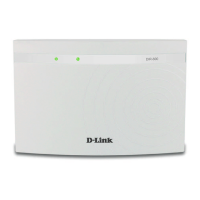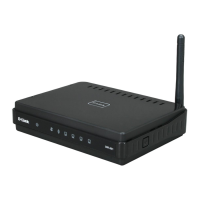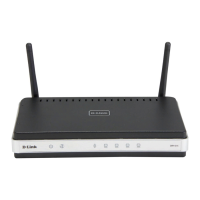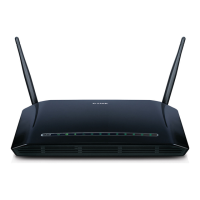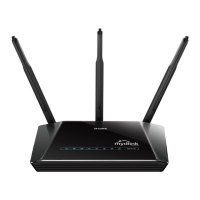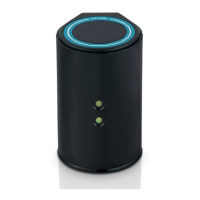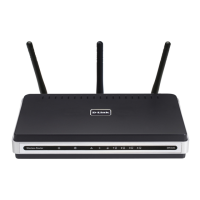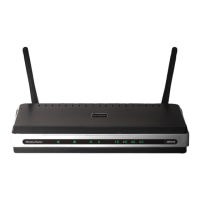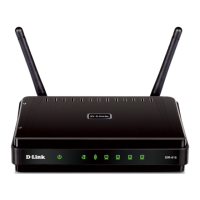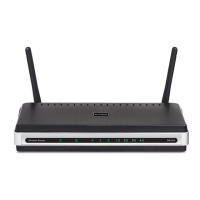Do you have a question about the D-Link DIR-600L and is the answer not in the manual?
Details revisions made to the manual.
Lists registered and unregistered trademarks.
Lists the necessary hardware and software for setup.
Highlights the key capabilities and benefits of the router.
Identifies physical components and ports on the router.
Explains how to connect various devices to the router.
Describes the function of each LED indicator on the router.
Provides initial setup considerations and prerequisites before installation.
Offers guidelines for optimal placement and performance of wireless setup.
Step-by-step guide for connecting the router to the modem.
How to access and use the router's web interface for settings.
Configures the router's connection to the internet (PPPoE, DHCP, etc.).
Manages wireless network settings, including security and SSID.
Configures the router's local area network settings and IP address.
Sets up firewall rules and DMZ host for network security and access.
Manages router access, including administrator passwords and remote management.
Instructions for updating the router's firmware to the latest version.
Guides on connecting to a wireless network using Windows XP utility.
Steps to set up WEP wireless security on the router and client.
Steps to set up WPA-PSK wireless security on the router and client.
Explains how to enable Wi-Fi protection on the router.
Details how to invite new devices to a secured Wi-Fi network.
Procedure to modify the computer's network name and workgroup settings.
Steps to connect the computer to a specific workgroup on the network.
Guide to setting up wireless connections via Windows XP.
How to create savable wireless network settings to a USB flash drive.
Steps to connect to a network protected by WEP, WPA-PSK, or WPA2-PSK.
Using command prompt to confirm IP configuration and test connectivity.
Procedure to connect to a wireless network without security.
Using command prompt to confirm IP configuration and test connectivity.
Solutions for issues accessing the router's web interface.
Steps to reset the router if the administrator password is forgotten.
Troubleshooting tips for connectivity problems with specific websites or services.
Basic explanation of wireless technology and its benefits.
Explains the fundamental principles of wireless data transmission.
Describes Infrastructure and Ad-Hoc modes of wireless networking.
How to find the computer's IP address using the command prompt.
Guide for manually assigning a static IP address to a computer.
Lists the wireless and wired communication standards supported by the router.
Details the various data transfer speeds supported by the wireless interface.
Outlines the security protocols and encryption methods supported.
Specifies the modulation techniques used for wireless communication.
Indicates the frequency bands used for wireless operations.
Lists advanced firewall functionalities like NAT, MAC filtering, and IP filtering.
Warning regarding potential radio interference in domestic environments.
Compliance statement and guidelines for FCC regulations.
Information on FCC limits for RF exposure and installation guidelines.
Details revisions made to the manual.
Lists registered and unregistered trademarks.
Lists the necessary hardware and software for setup.
Highlights the key capabilities and benefits of the router.
Identifies physical components and ports on the router.
Explains how to connect various devices to the router.
Describes the function of each LED indicator on the router.
Provides initial setup considerations and prerequisites before installation.
Offers guidelines for optimal placement and performance of wireless setup.
Step-by-step guide for connecting the router to the modem.
How to access and use the router's web interface for settings.
Configures the router's connection to the internet (PPPoE, DHCP, etc.).
Manages wireless network settings, including security and SSID.
Configures the router's local area network settings and IP address.
Sets up firewall rules and DMZ host for network security and access.
Manages router access, including administrator passwords and remote management.
Instructions for updating the router's firmware to the latest version.
Guides on connecting to a wireless network using Windows XP utility.
Steps to set up WEP wireless security on the router and client.
Steps to set up WPA-PSK wireless security on the router and client.
Explains how to enable Wi-Fi protection on the router.
Details how to invite new devices to a secured Wi-Fi network.
Procedure to modify the computer's network name and workgroup settings.
Steps to connect the computer to a specific workgroup on the network.
Guide to setting up wireless connections via Windows XP.
How to create savable wireless network settings to a USB flash drive.
Steps to connect to a network protected by WEP, WPA-PSK, or WPA2-PSK.
Using command prompt to confirm IP configuration and test connectivity.
Procedure to connect to a wireless network without security.
Using command prompt to confirm IP configuration and test connectivity.
Solutions for issues accessing the router's web interface.
Steps to reset the router if the administrator password is forgotten.
Troubleshooting tips for connectivity problems with specific websites or services.
Basic explanation of wireless technology and its benefits.
Explains the fundamental principles of wireless data transmission.
Describes Infrastructure and Ad-Hoc modes of wireless networking.
How to find the computer's IP address using the command prompt.
Guide for manually assigning a static IP address to a computer.
Lists the wireless and wired communication standards supported by the router.
Details the various data transfer speeds supported by the wireless interface.
Outlines the security protocols and encryption methods supported.
Specifies the modulation techniques used for wireless communication.
Indicates the frequency bands used for wireless operations.
Lists advanced firewall functionalities like NAT, MAC filtering, and IP filtering.
Warning regarding potential radio interference in domestic environments.
Compliance statement and guidelines for FCC regulations.
Information on FCC limits for RF exposure and installation guidelines.
| power input voltage | 5 V DC |
|---|---|
| power input current | 1 A |
| operating temperature | 32 to 104 ˚F (0 to 40 ˚C) |
|---|---|
| operating humidity | 0% to 90% non-condensing |
| wireless frequency range | 2.4 GHz to 2.4835 GHz |
| dimensions | 112 x 152 x 28 mm |
|---|---|
| weight | 0.5 lb |
